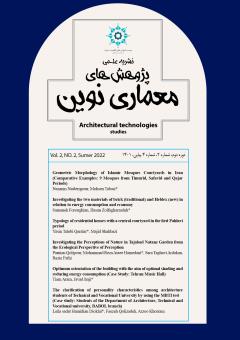Typology of the body of residential houses with a central courtyard in the first Pahlavi period
Subject Areas :Yasin Talebi Garalar 1 , majid shahbazi 2 *
1 - PhD Candidate Of Architecture, Department of Architecture, Zanjan Branch, Islamic Azad University, Zanjan, Iran
2 - Assistant Professor, Department of Architecture, Zanjan Branch, Islamic Azad University, Zanjan, Iran
Keywords: Central courtyard, First side, Typology, Traditional houses, Physical proportions,
Abstract :
The central yard, as an efficient and responsive device, has done its job well in protecting residents from environmental, social and cultural conditions in different regions of Iran. The physical typology of the central courtyard in different regions of the country, especially the buildings related to the first Pahlavi period, is a topic that this research seeks to answer. For this purpose, traditional houses with courtyards from different cities of the country have been selected as study samples. This research aims to investigate the physical structure, patterns and various types of the central courtyard in traditional houses, to study the typology of these houses. In order to carry out the research, more than 60 examples of traditional houses in the historical area of different cities of Iran were identified and 23 houses that had complete information and documents were selected for classification. According to their nature, research data has been collected by referring to library sources and field observations. The results of the classification of the location of the courtyard in the building show that one construction front (with the building mass on the northern side of the courtyard) has the most and buildings with two courtyards on both sides of the building have the lowest frequency among the samples studied. Also in In the longitudinal classification, 15.1-25 has the highest frequency, while in the transverse classification, the maximum frequency belongs to 15.1-20. Yards with an area of 100 to 400 square meters have the highest frequency among the samples studied. In the classification of proportions, the highest frequency is related to the proportions of 1.1 and the lowest is related to 1.5, which indicates the stretching of the yards towards the square. After the classification and comparison, Tousizadeh house has been chosen as the representative of the species with the highest abundance and Ganjalizadeh house as the representative of the species with the least abundance in the study context.
1- اخوت، ه. (1392). بازشناسی هویت دینی در مسکن سنتی (نمونه موردی: شهر یزد). رساله دکتری رشته معماری، دانشگاه تربیت مدرس، دانشکده هنر و معماری
2- جلیلی، تورج و سروش اکبری، (1395)، برسی تحولات پلانهای مسکونی از دوره قاجار تا پهلوی دوم، اولین کنفرانس سالانه پژوهشهای معماری، شهرسازی و مدیریت شهری
3- رفیعی سرشکی، ب.، رفیع زاده، ن.، و رنجبر کرمانی، ع. (1382). فرهنگ مهرازی (معماری) ایران. انتشارات مرکز تحقیقات ساختمان و مسکن. تهران.
4- شرام، هلموت (1391)، خانههای افقی متراکم، ترجمه علی غفاری و مریم میرکریمی، تهران، انتشارات دانشگاه شهید بهشتی تهران، چاپ اول
5- قبادیان، و. (1384). بررسی اقلیمی ابنیه سنتی ایران. انتشارات دانشگاه تهران. تهران.
6- کیانی، م. (1386). معماری دوره پهلوی اول: دگرگونی اندیشهها، پیدایش و شکلگیری معماری دورهی بیستسالهی معاصر ایران. چاپ دوم. مؤسسهی فرهنگی پژوهشی چاپ و نشر نظر. تهران.
7- معماریان، غ. (1375). آشنایی با معماري مسکونی ایرانی، گونه شناسی درونگرا. انتشارات سروش دانش. تهران.
8- مهدوی نژاد، م.، منصورپور، ک.، و هادیانپور، م. (1393). نقش حیاط در معماری معاصر ایران، مطالعه موردی: دورههای قاجار و پهلوی. نشریه مطالعات شهر ایرانی- اسلامی، 15، 35-45.
9- Bridson, D., & Design, S. U. (2012). Courtyard Housing Study. Djingis Khan and The Kingo Houses ″, ASBN26, Sustainable Urban Design Lund University.
10- Edwards, B., Sibley, M., Land, P., & Hakmi, M. (Eds.). (2006). Courtyard housing: past, present and future. Taylor & Francis.
11- Monestiroli, A. (2004). L'architettura della realtà, Milano politecnico, Publisher Allemandi.

